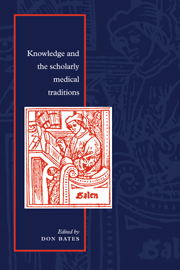Book contents
- Frontmatter
- Contents
- List of illustrations
- List of contributors
- Acknowledgements
- 1 Scholarly ways of knowing: an introduction
- Part 1 Scholarly medicine in the West
- Part 2 Chinese traditional medicine
- 9 Text and experience in classical Chinese medicine
- 10 Visual knowledge in classical Chinese medicine
- 11 A deathly disorder: understanding women's health in late imperial China
- 12 Re-writing traditional medicine in post-Maoist China
- Part 3 Āyurvedic medicine
- Part 4 Commentaries
- Index
10 - Visual knowledge in classical Chinese medicine
Published online by Cambridge University Press: 01 February 2010
- Frontmatter
- Contents
- List of illustrations
- List of contributors
- Acknowledgements
- 1 Scholarly ways of knowing: an introduction
- Part 1 Scholarly medicine in the West
- Part 2 Chinese traditional medicine
- 9 Text and experience in classical Chinese medicine
- 10 Visual knowledge in classical Chinese medicine
- 11 A deathly disorder: understanding women's health in late imperial China
- 12 Re-writing traditional medicine in post-Maoist China
- Part 3 Āyurvedic medicine
- Part 4 Commentaries
- Index
Summary
The main fact, then, about a flower is that it is the part of the plant's form developed at the moment of its intensest life; and this inner rapture is usually marked externally for us by the flush of one or more of the primary colours.
John Ruskin, Queen of the AirHow should we understand the strange disparities between the human body described in classical Greek medicine, and the body envisaged by physicians in ancient China? How is it that this basic and most intimate of human realities came to be conceived by two sophisticated civilizations in radically diverging ways?
We glimpse the legacy of this divergence in illustrations from two works of later Chinese and European medicine – the Shisi jing fahui by the Yuan dynasty physician Hua Shou (Plate 1), and Andreas Vesalius' Fabrica (Plate 2). Viewed side by side, the illustrations each betray ‘lacunae’. In Hua Shou's figure, we miss the precisely articulated muscles of the Vesalian man; and indeed, traditional Chinese medicine had no true equivalent for the notion of muscle. Fascination with musculature was a peculiarly Western phenomenon. Conversely, the points mapping out the acupuncture man eluded Vesalius' vision of the body – necessarily, since they were, even to Chinese eyes, invisible. Thus, when Europeans in the seventeenth and eighteenth centuries began to peruse Chinese medical literature, the descriptions of the body they encountered appeared to them like accounts of an imaginary land – ‘fantastical’, one English physician would deem them, ‘absurd’, would judge another.
- Type
- Chapter
- Information
- Knowledge and the Scholarly Medical Traditions , pp. 205 - 234Publisher: Cambridge University PressPrint publication year: 1995
- 5
- Cited by



